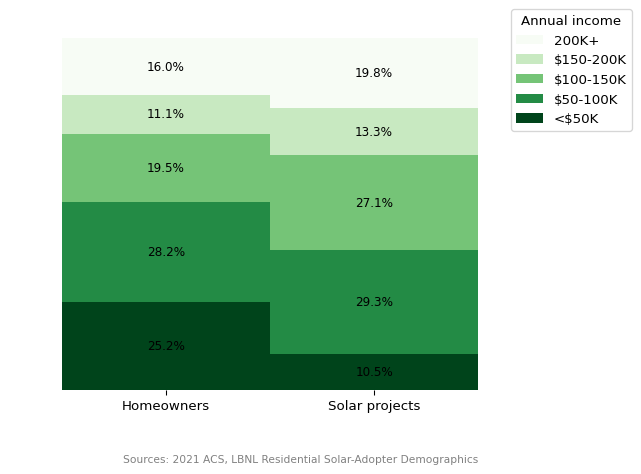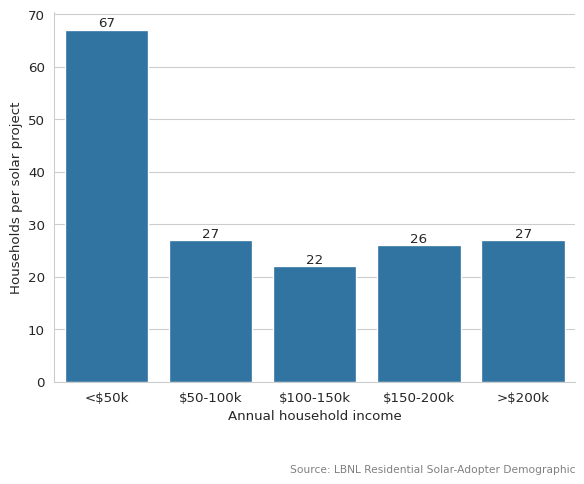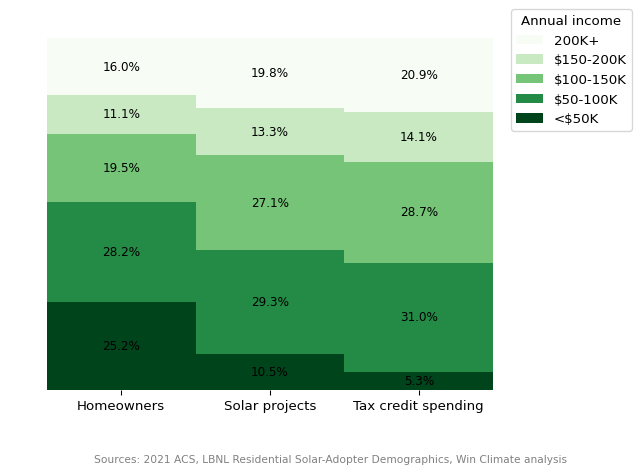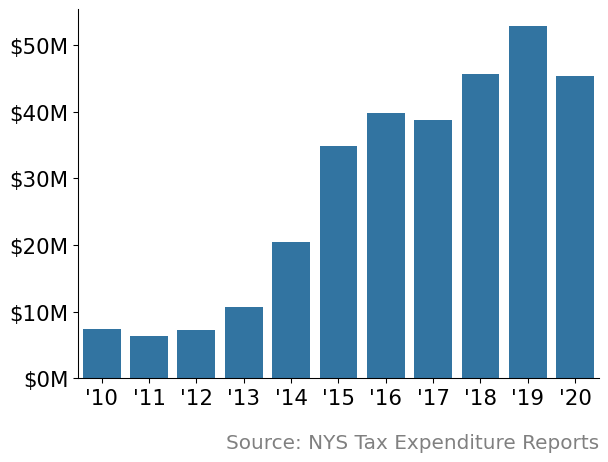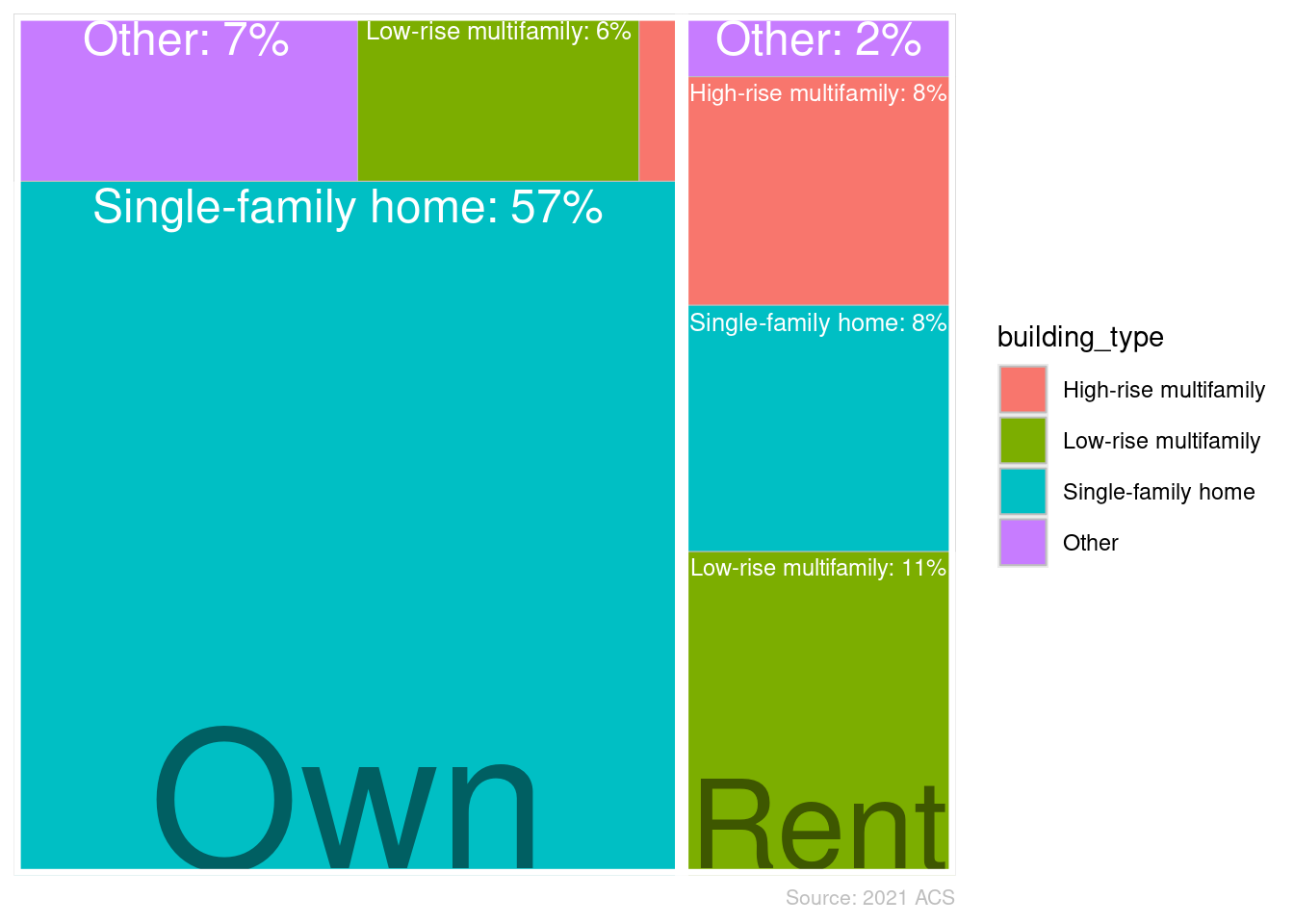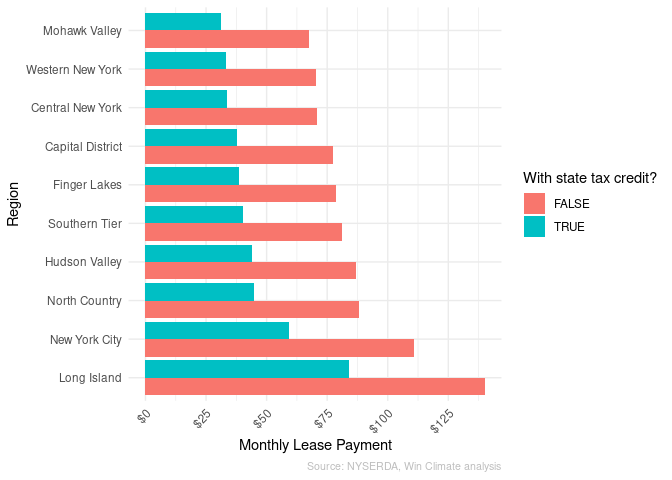Introduction
New York State’s Solar Tax Credit is the largest of several state incentives available to homeowners installing rooftop solar. The credit can pay for 25% of a residential rooftop solar installation, or $5,000, whichever is less.
The Residential Solar Tax Credit Reform Act (S3596/ A6739) updates the current tax credit to make it fully refundable, so that low-income homeowners and people living in disadvantaged communities can also benefit from this incentive.1 The Act also increases the tax credit amount to $10,000, which has not been updated since 2006.
1 §1 of S3596/A6739 (Harckham and Walker 2024) allows residents to receive the full incentive from the state, regardless how much they owe in income tax. Today, a homeowner installing a $20K system that owes $1K in taxes would only receive $1K, not the full $5K they are eligible for.
This report places the Residential Solar Tax Credit Reform Act in context, by analyzing New York’s rooftop solar gap, tracking which households have taken advantage of the current State Solar Tax Credit, and examining how the Residential Solar Tax Credit Reform Act (S3596/A6739) would impact the cost of solar for low-income New Yorkers.
- Rooftop solar gap
-
The difference in rooftop solar installation rates between households making more and less than $50,000
Executive Summary
Analyzing solar installation data from NYSERDA and Lawrence Berkeley National Lab, we find that:
NY has a large rooftop solar gap: homeowners with an annual income above $50,000 are 2.5x more likely to have rooftop solar than those making below $50,000, who don’t always pay enough income tax to claim the full credit.
NY’s solar tax credit is inequitable: households making less than $50,000 make up 24% of owner-occupied households in New York State, but have only received 5% of the state’s residential tax credit subsidies.
Refundable tax credits make solar more affordable: refundable residential tax credits could benefit up to 63% of New York’s 1.4 million energy-burdened households, and would cut the cost of solar for the average low-income household by 48%, from $98 to $51 a month.
Findings
NY’s Rooftop Solar Gap
How does a household’s income affect how likely it is to have rooftop solar in New York?
While 25% of all homeowners made less than $50,000 a year, these households installed only 10% of solar projects between 2010 and 2022. This is New York State’s rooftop solar gap.
If solar was being deployed equitably, we’d expect homeowners with annual incomes under $50,000 to receive a quarter of the state’s rooftop solar projects, not a tenth. Closing the solar gap would require growing these homeowners’ share of the solar installation pie by 2.5x.
Unequal installation rates
To understand what’s behind New York’s inequitable distribution of rooftop solar, we must examine solar installation rates.
Statewide, you have to look at 67 households making less than $50,000 to find one with rooftop solar, on average:
The contrast with higher-income households is striking: those with annual incomes above $50,000 are 2.5x more likely to have panels than those below.
But it is not the case that the higher a household’s income, the more likely they are to have solar panels on their roof. In fact, solar penetration rates are similar for all income buckets above $50,000, ranging from 22 to 27 households per project.
Rather, there are appears to be a tipping point around $50,000: households making between $50,000-100,000 are just as likely to have panels as those making more than $200,000. And they are all more than twice as likely to have rooftop solar than households making less than $50,000 a year.
Discussion
What could be driving this “two tier” disparity in installation rates?
High up-front costs: solar panels are expensive, costing tens of thousands of dollars to install, so lower income people often can’t afford them. The rise of solar leases, which allow homeowners to rent solar panels while paying nothing up-front, has significantly lowered up-front cost as an obstacle to adoption, however.
Low creditworthiness: while low incomes present less of an obstacle to solar installation than in the past, low credit scores can still act as a barrier to adoption. Creditworthiness problems are somewhat mitigated, however, by the fact that panels can a. be repossessed in the event of a default, and b. lower the risk of defaults in the first place by generating bill savings.
Exclusion from tax credits: the sudden drop in solar penetration below $50,000 can be partly explained by the fact that neither the state nor the federal tax credit for rooftop solar are refundable, which means that many low-income households are effectively excluded from subsidies that dramatically lower the up-front cost of rooftop solar: while the state’s credit covers 25% of the project cost (up to $5,000), the federal solar tax credit pays for an additional 30% (uncapped).2 Homeowners able to claim both credits can pay for less than half of their solar system, while homeowners with insufficient tax liability to claim either must pay for the entire cost.
2 The federal Residential Clean Energy Credit administered by the IRS just received a 10-year extension through the Inflation Reduction Act.
NY’s solar tax credit is inequitable
Tracking who has received New York’s solar tax credit supports our hypothesis that lower-income households are unable to fully claim the tax credit, and that their exclusion has contributed to the state’s rooftop solar gap.
The following chart shows the annual incomes of homeowners who received the tax credit subsidy between 2010 and 2022:
We estimate that homeowners making less than $50,000 a year received only 5% of the $309M the state spent on the solar tax credit program between 2010 and 2022 (Figure 4).
In other words, the fact that the state tax credit is non-refundable not only contributes to lower installation rates among lower-income homeowners (Figure 2), which are responsible for the bottom 25% ending up with only 10% of the panels (Figure 1).
Non-refundability also ensures that low-income homeowners who do manage to install solar end up receiveing lower subsidies, on average. Since homeowners making under $50,000 installed 10% of solar projects, we’d expect them to have receive closer to 10% of subsidy spending, not 5% (Figure 3). This discrepancy is largely caused by low-income households that lack enough tax liability to claim the full tax credit.
Discussion
By law, New York State is required to spend 35% of its clean energy investments on disadvantaged communities.3 Given that only 5% of tax credit spending is going to homeowners making under $50,000 a year, however, the state’s solar tax credit program is unlikely to be in compliance with the state Climate Act.
3 See §2 of the Climate Leadership and Community Protection Act (Kaminsky and Englebright 2019)
4 NYSERDA and the Public Service Commission have adopted a goal of 10GW of distributed solar statewide by 2030, 40% of which must go to low- to-moderate income residents, disadvantaged and environmental justice communities under the Solar Energy Equity Framework (NYSERDA 2021)
On top of legal obligations, New York State is explicitly committed to the equitable deployment of rooftop solar.4 At present, instead of furthering this goal, the state’s solar tax credit works against it.
Achieving equity would mean using subsidies to help the quarter of homeowners that make under $50,000—which contain the majority of the state’s energy-burdened residents—to receive a quarter of the solar installations.5 By excluding the lowest income homeowners from the generous subsidies given to the everyone else, the state tax credit is widening New York’s rooftop solar gap, not shrinking it.
5 In fact, since lower income homeowners usually need more financial assistance to adopt rooftop solar, achieving equity would likely require directing more than a 25% of subsidies to this population, not 5%.
Making the state tax credit refundable would not fully solve rooftop solar’s equity problem: the tax credit can only be claimed by homeowners, and many households earning less than $50,000 are renters. But making New York’s biggest rooftop solar subsidy not actively regressive would represent a major step forward nevertheless.
Refundable tax credits make solar more affordable
New York State is experiencing an energy affordability crisis. One in four households spend more than 6% of their annual income on energy bills, forcing many to choose between turning on the heat and putting food on the table.6 Utilities across the state are hiking rates, worsening the problem.7
6 See Win Climate’s recent energy affordability report, (Shron and Velez 2024)
7 Over the past year, all but one of New York’s investor-owned utilities has recently received or requested a rate hike. For context, see (Kinniburgh 2023)
How many could benefit?
What impact could the Residential Solar Tax Credit Reform Act have on these energy-burdened New Yorkers?
Statewide, 92% of households with high energy burdens are low-to-moderate income. 8 And despite the widespread perception that low-to-moderate income households are overwhelmingly renters, 71% of high-burden households actually own their own homes:
8 According to data from the Census Bureau’s 2022 American Community Survey, as analyzed in (Shron and Velez 2024)
Furthermore, 88% of these highly-burdened homeowners live in single family or low-rise multifamily buildings. Unlike residents of large multifamily buildings, where the savings from rooftop solar get diluted over many units, these households may be able to meaningfully cut their electricity bills by installing panels.
In total, making the tax credit fully refundable could benefit up to 63% of all highly energy-burdened families in New York.
What’s the impact on solar costs?
Would making the tax credit refundable actually bring down the cost of rooftop solar for low-income households?
Yes. For homeowners who are currently excluded from the state’s tax credits, our analysis finds that Residential Solar Tax Credit Reform Act would cut their cost of leasing a 5kW solar system by 48% on average, from $97 to $51 a month.9
9 Assuming a 20-year lease on a 5kW system at current costs, modeled as a loan with an 8% interest rate, including a reduction in up-front cost from the 30% federal commercial solar tax credit, NYSERDA’s NY Sun rebate and affordable residential adder.
That’s the statewide average. Since the cost of installing the same number of panels varies across the state, so does the Act’s impact on the cost of solar, viewed in terms of monthly lease payments:
About Win Climate
Win Climate is a think tank that provides legislators and advocates with rigorous and actionable data on state climate policy.
Our team of data scientists and policy experts brings evidence-based insight to climate and energy issues.
Find out more at climate.win.
Acknowledgments
The authors would to thank Kate Selden and Anika Wistar-Jones at SolarOne for their insights, Lizzy Oh at Spring Street Climate Fund and Noah Ginsburg at NYSEIA for their feedback, and James Carter and Richard Caperton at Arcadia for graciously giving us access to their Signal dataset and Switch engine.
Data & Methods
The solar-project-by-income percentages in Figure 1 and Section 3.1 are based on the Residential Solar-Adopter Income and Demographic datasets from Lawrence Berkeley National Lab (LBNL), which counts the number of solar projects within each NYS county at each income level. To produce this data, LBNL gets unanonymized solar project records from NYSERDA, and gets household income data from a third-party data broker by matching on address.
The homeowners-by-income percentages in Figure 1 and Section 3.1 come from the 2021 American Community Survey from the Census Bureau. We identified owned-occupied households in across the state, and bucketed them into the same income buckets used by LBNL.
The yearly tax expenditure figures in Figure 4 come from on New York State Tax Expenditure Reports for FY2016 through FY2022.
The tax-credit-spending-by-income in Section 3.2 is based on a tax simulation performed by Win Climate using the LBNL data: we look at every household which got solar within a certain income bucket, and calculate their tax liability by applying the state and city tax brackets for their county. To estimate the tax credit value they receive, we assume that they took the maximum credit available to them: 25% of the project cost or $5000, up to the maximum of their tax liability.
Figure 5 and the figures in Section 3.3.1 is also based on the 2021 American Community Survey from the Census Bureau. We identify New York households, and buck them occuring to their ownership status and building type.
Figure 6 and the figures in Section 3.3.2 on open data from the NY Sun program by NYSERDA. To estimate monthly lease payment per economic region, we fit a linear regression model for every region of the total project cost of residential solar projects minus the NY Sun rebate granted by NYSERDA. We used this model to predict the cost of the post-rebate installation cost of a 5kW array in each region. We applied the federal solar tax credit (30% off the post-rebate amount) and the NY Sun Residential Affordable Adder ($2K on Long Island, $4K everywhere else) to get our discounted up-front cost, with and without the state tax credit. We then modeled a solar lease as a 20-year, 8% loan on this principal, and calculated the monthly lease payments.
References
Reuse
Citation
@online{rajan2024,
author = {Rajan, Varun and Sinha, Snigdha and Shron, Max and Velez,
Juan-Pablo and Niu, Dorian and Duarte Neves, Francisco and Lam,
Joyce and Frost, Siena and Akar, Berkin},
title = {Closing {NY’s} {Rooftop} {Solar} {Gap}},
date = {2024-03-25},
langid = {en}
}
